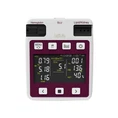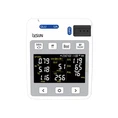The wholesale diabetic test strip (EGS-101) is a kind of consumables used in conjunction with blood glucose detectors, coated with biological enzymes, and can detect the amount of glucose in peripheral blood through their color changes.
The test strips are coated with an ultra-thin conductive layer (often gold), which are laser-polished into intricate circuits. In another machine, a chemical coating (containing glucose oxidase or glucose dehydrogenase) is applied to the end of the test strip. This biochemical cocktail works by reacting with glucose in the tester's blood to generate an electrical current. After the test strip is dry, it is time to go to another machine to open a track to receive the blood sample. At present, some of the common blood glucose test strips on the market are sucking blood at the top, some are sucking blood on both sides, and some are coated with blood on the surface. It is because the tracks opened during production are different. Finally, cut the prepared test strips into individual small test strips and seal them well to protect them from moisture and oxidation, which will affect the test results.
Main features
●Code Free: Start test after inserting strips.
●Tiny blood: 1μL.
●Rapid Test: In 5 Seconds.
●Large LCD: Large font, easy to read for the elderly.
●Intelligent Data: Automatic 7, 14 & 28 day averages.
●Large Memory: 200 records with date and time.
●Warning LO or HI for abnormal results.

preservation method
Test strips should be kept dry, protected from light and sealed. Blood sugar test strips are required to be placed in a dry environment, and the suitable temperature is between 10 degrees Celsius and 30 degrees Celsius. Under normal circumstances, the test strips do not need to be stored in the refrigerator, but they are easily affected by moisture and affect the test results. If the indoor temperature is too high in summer, you can put the test strip in a plastic bag, put a desiccant at the same time, and then put it in the refrigerator. After taking it out of the refrigerator before each test, wait for the test paper tube to return to room temperature, and then open the cover to take the test paper for testing; do not remove the test paper before the test paper tube reaches room temperature, so as to avoid the formation of condensation water in the test paper tube.
Make sure that the unused test strips are always stored in the original tube, do not pack the test strips in other containers (including old tubes), and do not mix the used test strips in the current test paper tube. Pay attention to the expiration date of the test strip and make sure to use it up within the expiration date. Take out the test strip and close the lid immediately.
How to use
1. First of all, you should pay attention to the validity period of the test strips, and you cannot use expired test strips. Check the shelf life of blood glucose test strips before use.
2. The desiccant in the blood sugar test strip can keep the test strip dry. Each time the test strip is taken out, the lid should be tightly closed to prevent the test strip from being damp or the desiccant becoming invalid.
3. The test strip should be stored in the environment of 10-30 ℃, and should be stored in the box to prevent dust adsorption or moisture.
4. Only keep the test paper in the original test paper tube.
5. The support area of the test strip should be kept clean, do not touch it with fingers, and regularly scrub with water to avoid damage to the reaction area of the reaction membrane and affect the monitoring results.
6. Do not touch the test area and the dripping area of the test strip during use.
7. The blood collection site is generally the tip of the finger. Avoid the blood collection site too close to the nail, as this may increase the risk of infection.
8. After blood collection, use 75% alcohol to disinfect the skin. After the disinfection point is completely dry, use the disposable needle equipped with the blood glucose meter to puncture the skin 2 to 3 mm, and the blood will flow out naturally, so that the blood beads match the markings on the test strip, and avoid squeezing forcefully. Blood leads to abnormal exudation of tissue fluid, thereby ensuring the accuracy of blood glucose values.
Specification | |
Test Strip Model No. | EGS-101 |
Certification | CE0123 (for home & clinical use) |
Enzyme | Glucose oxidase |
Methodology | Electrochemistry Method |
Measurement Range | 20~600mg/dL or 1.1-33.3mmol/L |
Measurement Unit | mmol/L, mg/dL |
HCT | 30-55% |
Specimen | Fresh capillary or venous whole blood |
Specimen Volume | 1microlitre |
Measurement Time | 5 seconds |
Accuracy: glucose concentration < 5.55 mM (<100 mg/dl) | ||
Within ± 0.28 mM (within ± 5 mg/dl) | Within ± 0.56 mM (within ± 10 mg/dl) | Within ± 0.83 mM (within ± 15 mg/dl) |
137/246(55.7%) | 223/246(90.7%) | 246/246(100%) |
Accuracy: glucose concentration 5.55 mM (100 mg/dl) | ||
Within ± 5% | Within ± 10% | Within ± 15% |
194/474(40.9%) | 358/474(75.5%) | 461/474(97.3%) |
Accuracy: glucose concentration between 2.16 mM (38.88 mg/dl) and 31.57 mM (568.26 mg/dl) | ||
Within ± 0.83 mM or ± 15% (Within ± 15 mg/dl or ± 15%) | ||
707/720(98.2%) | ||
Delivery

FAQ
















